|
Mazda MX-5 (NC)
Debut: 2005
Maker: Mazda
Predecessor: MX-5 (late NB)
|
|
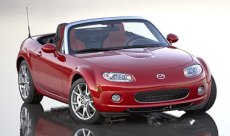 The
Chinese saying "Everybody sees winners as kings and losers as thieves"
applies to Mazda MX-5. When it was launched in 1989, many European
motor writers described it as a copycat to the original Lotus Elan,
criticized it for looking too feminine, laughed it for running too
slow. 16 years later, the MX-5 still standing solidly on the top of the
affordable roadster segment. With over 700,000 cars sold, it surpassed
the record set by MGA/B/C to be the world's best selling sports car of
all time. Now everybody sees it as a King. The
Chinese saying "Everybody sees winners as kings and losers as thieves"
applies to Mazda MX-5. When it was launched in 1989, many European
motor writers described it as a copycat to the original Lotus Elan,
criticized it for looking too feminine, laughed it for running too
slow. 16 years later, the MX-5 still standing solidly on the top of the
affordable roadster segment. With over 700,000 cars sold, it surpassed
the record set by MGA/B/C to be the world's best selling sports car of
all time. Now everybody sees it as a King.
Admittedly, the original MX-5 was really a copycat to Lotus Elan. Its
rear drive chassis, skinny tires, brilliant steering and suspension
setup make it incredibly agile and playable in the twisty. It proves
that you don't need huge power and grip to get exciting, provided you
have a well balanced chassis and interactive controls. In this way, it
follows 100% the formula set by Lotus Elan. However, Mazda succeeded to
bring the driving fun of Lotus at a bargain price and reliable build
quality that only the Japanese can achieve. This is what it made it so
successful.
The new MX-5
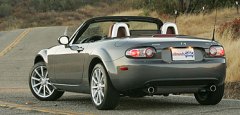 Mazda
had revised the MX-5 two times, one in 1997 and one in 2000. But
strictly speaking the revisions still belong to the Mk1 car, as they
did no fundamental changes to the chassis. This means, while some
people refer the new MX-5 as Mk3 or Mk4, it is actually the second
generation. In the language of Porsche, if the original MX-5 were the
original 911, then the 2005 MX-5 would be 996, while the previous 2
revisions were 930 and 964. See the difference ? Mazda
had revised the MX-5 two times, one in 1997 and one in 2000. But
strictly speaking the revisions still belong to the Mk1 car, as they
did no fundamental changes to the chassis. This means, while some
people refer the new MX-5 as Mk3 or Mk4, it is actually the second
generation. In the language of Porsche, if the original MX-5 were the
original 911, then the 2005 MX-5 would be 996, while the previous 2
revisions were 930 and 964. See the difference ?
At the first sight, the new MX-5 is not very beautiful. It looks
bolder, stronger and straighter. While the Mk1 looked sleek, light and
nimble, the new car looks like a solid brick, just with edges and
corners smoothened. Part of the reason is the high and flat bonnet,
which is designed to comply with the new EU pedestrian safety law. This
law requires substantial clearance to be left between the bonnet and
the engine so that the bonnet can absorb the impact energy when a
pedestrian is hit onto it. Unfortunately, it kills the sloping front
end a sports car desperately needed.
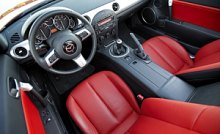 Inside,
the cabin design is another disappointment. For this pure sports car we
expect a "simple is beautiful" design theme like BMW Z4. But in fact
its design is too complicated and fuzzy. The center console is
definitely the ugliest part of all, which could have been found in any
economy sedans. After the stylish RX-8, we can't help disappointed with
the exterior and interior design of the new MX-5. Inside,
the cabin design is another disappointment. For this pure sports car we
expect a "simple is beautiful" design theme like BMW Z4. But in fact
its design is too complicated and fuzzy. The center console is
definitely the ugliest part of all, which could have been found in any
economy sedans. After the stylish RX-8, we can't help disappointed with
the exterior and interior design of the new MX-5.
From practicality point of view, however, the new cabin is definitely
better. Not only provides slightly more space all round, the materials
and build quality are markedly improved. The fabric roof is even easier
to operate. It is still a manual job (to keep cost down), but what you
need is just to disengage a latch at the windscreen and push the soft
roof rearward, and then it will recess into a dedicated storage space
behind the seats. The whole operation can be done in your seat, no need
to climb out the car like Pontiac Solstice. With the roof down, you can
enjoy fresh air without troubling by too much buffeting. What a pity
you can no longer rest your arms naturally on the top of the door as
before, because the shoulder line is raised along with the bonnet.
Admittedly, all other new roadsters have the same problem.
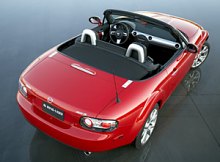 The new
MX-5 grew just 4 cm in length and 4 cm in width. Therefore it is still
a very compact car. Its chassis gained 22% torsional stiffness yet the
kerb weight is up by only 10 kilograms. This means a lot of weight
saving materials have been used, such as aluminum bonnet, aluminum
suspension control arms and most important, the new MZR engine has
aluminum block and thermoplastic intake manifold. The longitudinal
engine is also moved 13.5 cm rearward in order to achieve 50:50 weight
distribution and concentrate the mass around the center of the car. Now
the whole engine locates behind the front axle, qualifying as a
front-mid-engined car like RX-8. Also following the RX-8, it uses
double-wishbones suspensions up front and 5-link suspensions at the
rear. The new
MX-5 grew just 4 cm in length and 4 cm in width. Therefore it is still
a very compact car. Its chassis gained 22% torsional stiffness yet the
kerb weight is up by only 10 kilograms. This means a lot of weight
saving materials have been used, such as aluminum bonnet, aluminum
suspension control arms and most important, the new MZR engine has
aluminum block and thermoplastic intake manifold. The longitudinal
engine is also moved 13.5 cm rearward in order to achieve 50:50 weight
distribution and concentrate the mass around the center of the car. Now
the whole engine locates behind the front axle, qualifying as a
front-mid-engined car like RX-8. Also following the RX-8, it uses
double-wishbones suspensions up front and 5-link suspensions at the
rear.
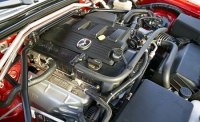 The
powerplant of MX-5 is a 2.0-litre twin-cam 16V MZR engine. It is lifted
from Mazda 6, getting higher tuning, a 2-stage intake manifold and S-VT
variable valve timing to the intake side. In Japan and USA it is rated
at 170 horsepower at 6700 rpm, accompany with 139 lbft of torque. That
is considerably more powerful than the old car's 146 hp 1.8-litre
engine, no wonder R&T recorded 0-60 mph in 7.0 sec and 0-100 mph in
21.5 sec. That's about 1 second and 3 second respectively faster than
before. The
powerplant of MX-5 is a 2.0-litre twin-cam 16V MZR engine. It is lifted
from Mazda 6, getting higher tuning, a 2-stage intake manifold and S-VT
variable valve timing to the intake side. In Japan and USA it is rated
at 170 horsepower at 6700 rpm, accompany with 139 lbft of torque. That
is considerably more powerful than the old car's 146 hp 1.8-litre
engine, no wonder R&T recorded 0-60 mph in 7.0 sec and 0-100 mph in
21.5 sec. That's about 1 second and 3 second respectively faster than
before.
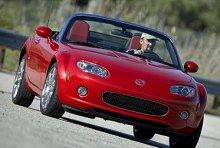 That
performance might not be a headline in nowadays. But you should know
performance has never been the most beautiful part of the MX-5. It is
the interaction between the car and the driver that counts. First of
all, the linear and free-revving engine is a good companion to the
driver, as is the slick and short gearchange from the superb gearbox.
Over rough surfaces the suspensions absorb bumps better than the old
car. Coming close to a bend, apply braking, the progressive pedal is
easy to modulate. Turn the nicely weighted wheel, the turn-in is
instant, showing how little weight hanging at the nose. In the corner
the wheel also transmit streams of road feel into the driver's hands.
At the same time, the MX-5 corners noticeably faster and flatter than
the old car - this is the biggest difference of their cornering manner.
Trail the throttle, the rear end moves out in a progressive way. Prod
the throttle and it resume balance. So easy, so playful. Few sports
cars can be as playable at the limit, certainly not those big power,
wide rubber machines. That
performance might not be a headline in nowadays. But you should know
performance has never been the most beautiful part of the MX-5. It is
the interaction between the car and the driver that counts. First of
all, the linear and free-revving engine is a good companion to the
driver, as is the slick and short gearchange from the superb gearbox.
Over rough surfaces the suspensions absorb bumps better than the old
car. Coming close to a bend, apply braking, the progressive pedal is
easy to modulate. Turn the nicely weighted wheel, the turn-in is
instant, showing how little weight hanging at the nose. In the corner
the wheel also transmit streams of road feel into the driver's hands.
At the same time, the MX-5 corners noticeably faster and flatter than
the old car - this is the biggest difference of their cornering manner.
Trail the throttle, the rear end moves out in a progressive way. Prod
the throttle and it resume balance. So easy, so playful. Few sports
cars can be as playable at the limit, certainly not those big power,
wide rubber machines.
Since the very beginning, throttle steer has been the core value of
MX-5. We are glad that the new MX-5 retains this DNA. Simultaneously,
it gained higher performance, higher cornering limit, sharper turn-in
and nicer ride. This is not easy to achieve. You know, most other
roadsters lost driver interaction during the modernization process. In
this way, the Mazda engineering team is definitely successful. What a
pity their design studio did not submit a more beautiful proposal !
|
| The
above report was last updated on 22 Sep
2005. All Rights Reserved. |
MX-5 Roadster Coupe
|
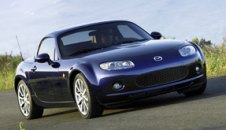 With
the addition of Roadster Coupe, Mazda MX-5 becomes the first car to
offer soft roof and retractable hard roof simultaneously. You might
question the need for retractable roof, which adds costs, complexity
and weight to the already excellent cabriolet. Perhaps Mazda wants to
prove that it is still running in the forefront of fashion. You know,
the little roadster used to be a symbol of niche in the early 1990s. With
the addition of Roadster Coupe, Mazda MX-5 becomes the first car to
offer soft roof and retractable hard roof simultaneously. You might
question the need for retractable roof, which adds costs, complexity
and weight to the already excellent cabriolet. Perhaps Mazda wants to
prove that it is still running in the forefront of fashion. You know,
the little roadster used to be a symbol of niche in the early 1990s.
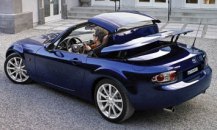 Anyway,
adding retractable roof to the MX-5 is an easier job than in other
cars. The price it paid is also relatively little. This is because the
roadster was designed as an open-top car from the beginning. Its
chassis structure provides enough strength, so adding a hard roof does
not require compensating reinforcement. The same goes for storing the
roof. Because it has only 2 seats, the roof is relatively small and
simple – it consists of only 2 small panels – so that it takes barely
more storage space than the original fabric roof, while it adds only 37
kilograms to the car. Anyway,
adding retractable roof to the MX-5 is an easier job than in other
cars. The price it paid is also relatively little. This is because the
roadster was designed as an open-top car from the beginning. Its
chassis structure provides enough strength, so adding a hard roof does
not require compensating reinforcement. The same goes for storing the
roof. Because it has only 2 seats, the roof is relatively small and
simple – it consists of only 2 small panels – so that it takes barely
more storage space than the original fabric roof, while it adds only 37
kilograms to the car.
The 2-seater chassis suffers from very little loss in rigidity while
the added burden is less than the weight of a passenger, therefore MX-5
Roadster Coupe goes and handles very much like the original car. What
it gains is superior noise insulation compare with the soft top, plus
the sensation when the roof mechanism automatically opens and closes in
12 seconds. My only reservation is the elevated boot lid and hood
cover, which make the car look fatter. |
| The
above report was last updated on 21 Sep
2006. All Rights Reserved. |
MX-5 2008 facelift
|
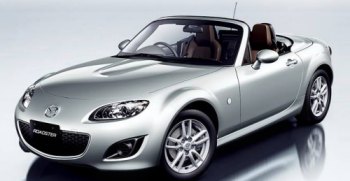 Affordable
2-seater roadsters are no longer selling hot in recent years. Following
the demise of Fiat Barchetta, MG TF, Smart Roadster and Toyota MR-S,
only Mazda MX-5 and GM's Kappa duo (Pontiac Solstice / Saturn Sky)
remain in the market. Although the Mazda is still clearly the segment
dominator, it sales is also declining faster than the company
anticipated. Therefore a facelift is considered to be necessary. In
late 2008 Mazda announced a facelift and mild revision to the MX-5. It
may help the car better sustain the bumpy 2009. Affordable
2-seater roadsters are no longer selling hot in recent years. Following
the demise of Fiat Barchetta, MG TF, Smart Roadster and Toyota MR-S,
only Mazda MX-5 and GM's Kappa duo (Pontiac Solstice / Saturn Sky)
remain in the market. Although the Mazda is still clearly the segment
dominator, it sales is also declining faster than the company
anticipated. Therefore a facelift is considered to be necessary. In
late 2008 Mazda announced a facelift and mild revision to the MX-5. It
may help the car better sustain the bumpy 2009.
To me, the 2nd generation MX-5 (note: Mazda called it 3rd gen) launched
3 years ago has never been an attractive design. Part of the reason is
a bland-looking nose. The facelift focuses your vision on a prominent
diamond-shape corporate grille, which locates further forward than the
two faux brake intakes (which house the fog lamps only) to deliver a
3-dimensional visual effect. The new grille also looks far more stylish
than the "Joker mouth" of the original design. However, the round
design theme of the car seems increasingly outdated these days. Limited
by budget, this facelift takes no time to reshape most of the sheet
metal and lights, otherwise it could have delivered a crisper and
edgier design theme that marks out Mazda 6. What a pity.
Predictably, revisions to the mechanical side are modest. Mazda gave us
a long list of modifications that cover engine, acoustic, sound
insulation, transmission, suspension and interior, but these
modifications are too small that most other car makers would introduce
as regular running change rather than mid-life revision. Take the
engine for example, power and torque figures and even torque curve
remain untouched. Mazda just fitted a forged crankshaft, fully floating
pistons and stiffer valve springs to raise its redline by 500 rpm, now
at 7500 rpm. Max power now occurs at 7000 rpm instead of 6700 rpm.
Changes to intake manifolds make the soundtrack more sporty. We are
glad to see the engine is more eager to rev and to sing, but we would
have been happier if it get direct injection and 10 more horsepower.
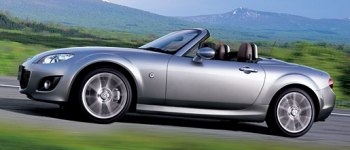 The 6-speed manual gearbox
should be slightly slicker to shift thanks to using carbon-coated
synchronizers from 1st to 4th gear and a larger synchronizer from 3rd
to 4th. Handling is improved by a revision to the front suspension
geometry. By altering the locations of ball joints in the front
knuckles, roll center has been lowered by 26 mm. Therefore the car
responds more linearly to steering. On the road, this mean the MX-5
turns into corner more cleanly and accurately. Ride quality is also
perceived to be better thanks to the lowered roll center. These changes
guarantee the Mazda continue to be the most rewarding roadster up to
the territory of Porsche Boxster. The 6-speed manual gearbox
should be slightly slicker to shift thanks to using carbon-coated
synchronizers from 1st to 4th gear and a larger synchronizer from 3rd
to 4th. Handling is improved by a revision to the front suspension
geometry. By altering the locations of ball joints in the front
knuckles, roll center has been lowered by 26 mm. Therefore the car
responds more linearly to steering. On the road, this mean the MX-5
turns into corner more cleanly and accurately. Ride quality is also
perceived to be better thanks to the lowered roll center. These changes
guarantee the Mazda continue to be the most rewarding roadster up to
the territory of Porsche Boxster.
Revisions to the cabin include a more powerful Bose sound system,
grippier Recaro seats, new dials and better sound insulation for the
retractable roof Roadster Coupe. Again, the limited budget does not
allow an overhaul to the uninspiring dashboard design. In short, the
2008 facelift enhances further the strengths of MX-5 but kept most of
its flaws untouched. A major update is still at least 2 years away.
|
| The
above report was last updated on 2 Jan 2009. All
Rights Reserved. |
|
|